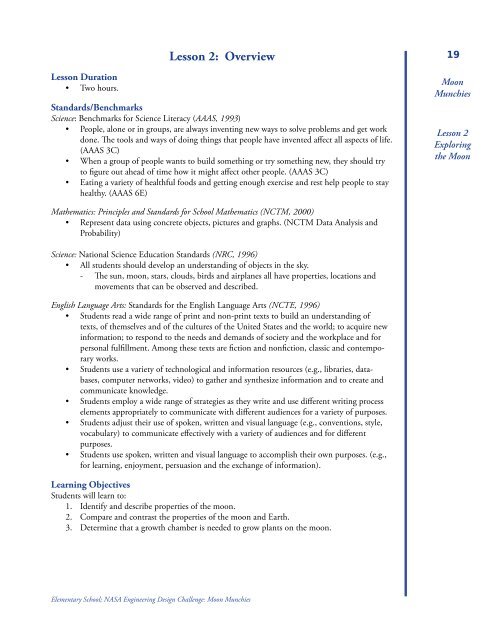Moon Munchies 2 pdf - ER - NASA
Moon Munchies 2 pdf - ER - NASA
Moon Munchies 2 pdf - ER - NASA
Create successful ePaper yourself
Turn your PDF publications into a flip-book with our unique Google optimized e-Paper software.
Lesson Duration• Two hours.Lesson 2: OverviewStandards/BenchmarksScience: Benchmarks for Science Literacy (AAAS, 1993)• People, alone or in groups, are always inventing new ways to solve problems and get workdone. The tools and ways of doing things that people have invented affect all aspects of life.(AAAS 3C)• When a group of people wants to build something or try something new, they should tryto figure out ahead of time how it might affect other people. (AAAS 3C)• Eating a variety of healthful foods and getting enough exercise and rest help people to stayhealthy. (AAAS 6E)19<strong>Moon</strong><strong>Munchies</strong>Lesson 2Exploringthe <strong>Moon</strong>Mathematics: Principles and Standards for School Mathematics (NCTM, 2000)• Represent data using concrete objects, pictures and graphs. (NCTM Data Analysis andProbability)Science: National Science Education Standards (NRC, 1996)• All students should develop an understanding of objects in the sky.-- The sun, moon, stars, clouds, birds and airplanes all have properties, locations andmovements that can be observed and described.English Language Arts: Standards for the English Language Arts (NCTE, 1996)• Students read a wide range of print and non-print texts to build an understanding oftexts, of themselves and of the cultures of the United States and the world; to acquire newinformation; to respond to the needs and demands of society and the workplace and forpersonal fulfillment. Among these texts are fiction and nonfiction, classic and contemporaryworks.• Students use a variety of technological and information resources (e.g., libraries, databases,computer networks, video) to gather and synthesize information and to create andcommunicate knowledge.• Students employ a wide range of strategies as they write and use different writing processelements appropriately to communicate with different audiences for a variety of purposes.• Students adjust their use of spoken, written and visual language (e.g., conventions, style,vocabulary) to communicate effectively with a variety of audiences and for differentpurposes.• Students use spoken, written and visual language to accomplish their own purposes. (e.g.,for learning, enjoyment, persuasion and the exchange of information).Learning ObjectivesStudents will learn to:1. Identify and describe properties of the moon.2. Compare and contrast the properties of the moon and Earth.3. Determine that a growth chamber is needed to grow plants on the moon.Elementary School; <strong>NASA</strong> Engineering Design Challenge: <strong>Moon</strong> <strong>Munchies</strong>
















